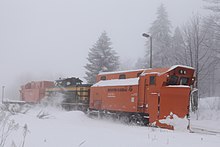Meiningen type snow plow

The Meiningen type snow plows are railway service vehicles that were procured by the Deutsche Reichsbahn in the GDR for clearing snow and drifting snow in the track area . According to their construction principle, these snow plows are also called climatic snow plows - after Rudolf Klima, an Austrian designer and inventor. The climate snow plows are able to clear snow up to 1.50 meters high to the side.
history
The Meiningen type snow plows were built from 1968 to 1981. The first four plows were still made in the Reichsbahnausbesserungswerk (RAW) Halberstadt , all others in RAW Meiningen , today's Meiningen steam locomotive works . The first series comprised 50 vehicles , which were later given the designation "Meiningen snow plow" to distinguish them. The second, improved series of 55 vehicles, built from 1978 onwards, was given the designation "Meiningen W snow plow" (W for intercom).
104 snow plows were brought into the Deutsche Bahn AG in 1994 . The plows were given the series number 855 from Deutsche Bahn.
In order to enlarge the operational radius and reduce the stock, the DB AG converted 30 vehicles. It was u. a. the top speed increased from 50 km / h to 100 km / h. To distinguish them, the converted vehicles were given the series designation 856.
In 1999 only 30 vehicles were still in stock, including two from the first series. Many of these snow plows were sold to private railways .
Design features
The Meiningen plow is a one-way snow plow, so it cannot be rotated on the chassis . It does not have its own drive, but relies on a push locomotive. The chassis and bogies of decommissioned tender of the type 2'2'T32 are used. The vehicles are 11.50 m long. The weight of the snow plow is brought to 54 tons by carrying concrete ballast.
The plowshares are constructed according to the principle developed by Rudolf Klima (vertically standing shares, wedge-shaped in the basic position for two-sided clearing, can be swung out for one-sided clearing), with side clearing blades. There is also a wedge-shaped internal track clearer. The ploughshare is moved by compressed air cylinders. The compressed air system must be fed by the locomotive ; the supply can either come from the main air tank line (10 bar) or from the main air line (5 bar). If a motor vehicle is used without an air drying system, alcohol must be added to the compressed air system on the snow plow in order to prevent the condensate that then increasingly forms from freezing.
A 110-volt direct current on- board network is available to supply various electrical consumers, which is fed by a diesel- powered generator . Alternatively, external power can be fed in. Among other things, the locomotives of the DR series V 100 were equipped for this. At the ploughshare a coupling solvent is present in a Notkupplung for towing of tram - railcar or a tie rod can be hung, so that the Meiningen snow plow also from the front side can be moved.
A small lounge for the staff is attached to the driver's cab of the snow plow, followed by the room for the generator. The snow plow crew consists of at least two people: a snow plow operator and a work driver . In the event of imminent danger, the main air line can be vented from the driver's cab of the snow plow, thus initiating braking of the combination. On the plows of the first series, the travel commands were transmitted via a light signal system attached to the end facing the locomotive. This could signal the desired driving speed between 10 and 50 km / h with five lamps, in addition, "Attention!" And "Stop!" Could be signaled. The traffic lights reached their limits if, for example, the snow plow had to be reset. Such orders had to be delivered orally.
Type Meiningen W
The second series has been improved in some points based on operational experience. The name was derived from the newly added intercom system , with which verbal communication with the driver was possible. It replaced the traffic lights.
From the 1990s, however, the top speed was again limited to 50 km / h for some plows. Further improvements related to the installation of a second generator set and a second worklight.
Web links
- Meiningen type snow plow at www.eisenbahndienstfahrzeuge
- Snow plow type Meiningen on Bahn-galerie.de
- Meiningen type snow plow with sliding locomotive
- Report on the use of snow plows in the winter of 1978/79
Individual evidence
- ↑ Construction principle of the climatic snow plow , accessed on February 1, 2010
